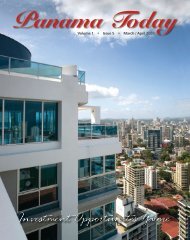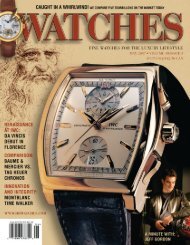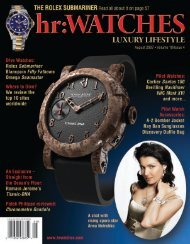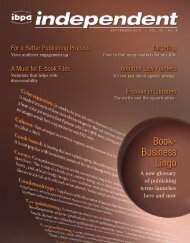Where the Growth Is
Where the Growth Is - Van-garde
Where the Growth Is - Van-garde
- No tags were found...
Create successful ePaper yourself
Turn your PDF publications into a flip-book with our unique Google optimized e-Paper software.
■The Language of Publishingor knocked out, so that <strong>the</strong>ywill not be covered with ink.Portions that are knocked outmay appear in <strong>the</strong> color of <strong>the</strong>cover stock. Knockouts are importantbecause <strong>the</strong>y prevent<strong>the</strong> color of a final ink such as apastel from being distorted byan earlier bright or dark color.LLarge print: Usually 18- or20-point type, large enough forcomfortable use by some readerswith visual impairments. Informationabout preparing materialsfor <strong>the</strong> visually impairedis available in “Best Practicesand Guidelines for Large PrintDocuments Used by <strong>the</strong> LowVision Community,” providedby <strong>the</strong> Council of Citizens withLow Vision International, an affiliateof <strong>the</strong> American Councilof <strong>the</strong> Blind, cclvi.org/largeprint-guidelines.html.Laminated: When a thinplastic film is applied to <strong>the</strong>outside cover of a book toprotect <strong>the</strong> surface (say, fromfingerprints or moisture) andenhance <strong>the</strong> appearance. Alsosee Coating.Laser printing: Typically doneby a desktop printer that, likea photocopy machine, uses anelectrostatically charged drumand toner to produce an imageon paper. Contrast with offsetlithography, which involvestransferring ink in a press froma printing plate to a rubberblanket to paper—a processwith more expensive makereadyand press cleanup thatis suitable for longer runs.Laser proofs: Paper outputfrom an electronic file; used asfinal proof before printing. Alsosee bluelines.Layflat binding: The processcreates a flexible spine sopages lie flat when a book isopen; popular for cookbooksand how-to books, when directionsare likely to be read asa project is in process. Brandsinclude Otabind and Repkover.Layout: The depiction of adesign (as in “laying out <strong>the</strong>cover”). Also, what desktoppublishing software creates asan electronic substitute for <strong>the</strong>comprehensive, or pasteup.For additional reading:BISG Rights Controlled Vocabulary, bisg.org/docs/BISG%20Rights%20Controlled%20Vocabulary%201.0.pdfBook Design and Production: A Guide for Authors andPublishers, by Pete Masterson, Aeonix Publishing GroupBookmasters Publishing 101 by Bookmasters,bookmasters.com/authors.htmlDon’t Let Me Find You Bleeding in <strong>the</strong> Gutter: UnderstandingBook Terminology by Joel Friedlander,<strong>the</strong>bookdesigner.com/2011/06/dont-let-me-find-you-bleeding-in-<strong>the</strong>-gutter-understanding-book-terminologyNeenah Paper’s Glossary of Paper Terms, neenahpaper.com/resources/glossarytermsPBI Print Buyer Glossary, printbuyersinternational.com/resources/print-buyer-glossaryLeader: A title <strong>the</strong> publisherexpects will have high sales.Large publishers give leaderssignificant promotional support,including money for advertisingand author tours.Leading: The space betweenlines of type. Pronouncedas “led,” it is expressed as abaseline-to-baseline measure.Nine-point type leaded outat 12 points will be written as9/12 or phrased as “set 9 on12.” The space comes between<strong>the</strong> descenders of a lineand <strong>the</strong> ascenders of <strong>the</strong> nextline. Type set 9/18 will havemore space between linesthan type set 9/12 or 9/14.Type leaded too tightly will behard to read. The term derivesfrom <strong>the</strong> narrow metal stripsthat separated lines of metaltype in early typesetting.Letterpress: Today used mostoften for high-quality short-runjobs such as invitations andpersonal stationery, letterpresswas <strong>the</strong> primary method ofprinting everything for 500years, starting with Gutenberg.It was replaced for long-runand large jobs by offset lithographyin <strong>the</strong> mid-1900s. Alsodefined as relief printing, letterpressuses raised printingsurfaces such as those createdby <strong>the</strong> Linotype and o<strong>the</strong>rhot-metal typesetters or byengravings.Library binding: A reinforcedbinding offered by specialtybinderies. Publishers orderinga large quantity of booksbound for library sales mayhave <strong>the</strong>m prebound; o<strong>the</strong>rscan order extra covers to beused for rebinding paperbacksonce <strong>the</strong>ir original spines arecut off. Names of some librarybinders can be found on <strong>the</strong>Library Binders Institute Website,lbibinders.org.Line art: Images created witha single color and withouthalftones. Usually black-andwhitedrawings. Most clip artis line art.Lines per inch (lpi): This measures<strong>the</strong> resolution of a halftoneor line screen. The higher<strong>the</strong> lpi, <strong>the</strong> finer <strong>the</strong> screen and<strong>the</strong> sharper <strong>the</strong> image. SeeDots per inch.Logo: a graphic representationof an organization’s name. Oftenpart of its graphic identityin spine artwork, letterhead,catalogs, and signage.Low-resolution: Low-res imagescan be transmitted electronicallyfaster than higher-resimages, but <strong>the</strong>y have lessclarity, especially when enlarged,and may look blurred.Images such as stock photopreviews are provided in lowresolution for layout purposes;high-resolution images arenecessary for book production.MMake-ready: The same assetup, make-ready includes all28 | IBPA Independent | February 2013








